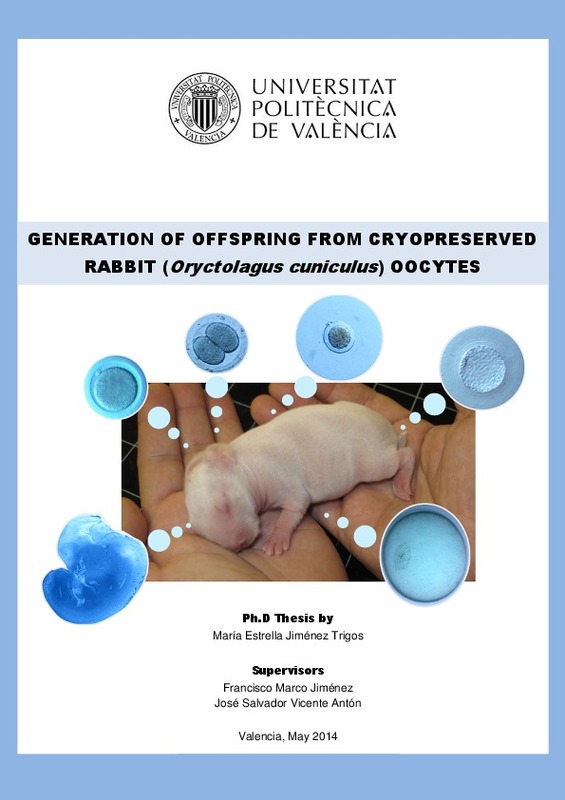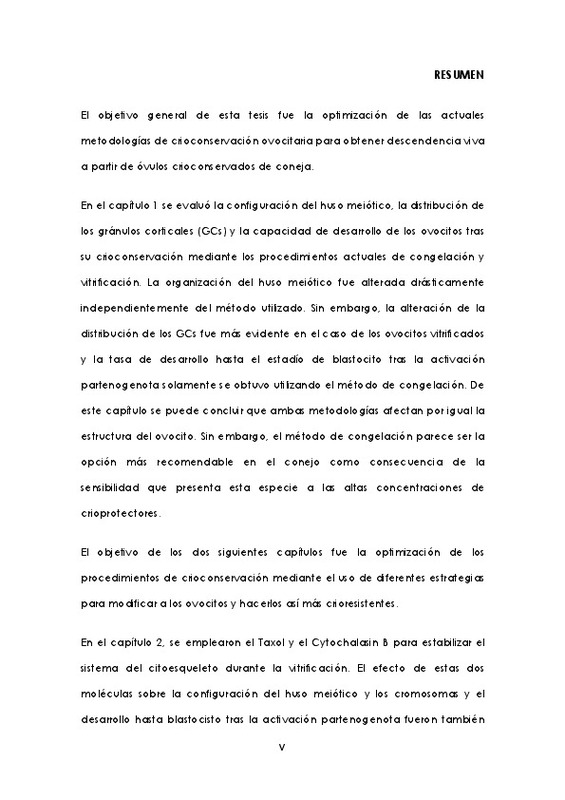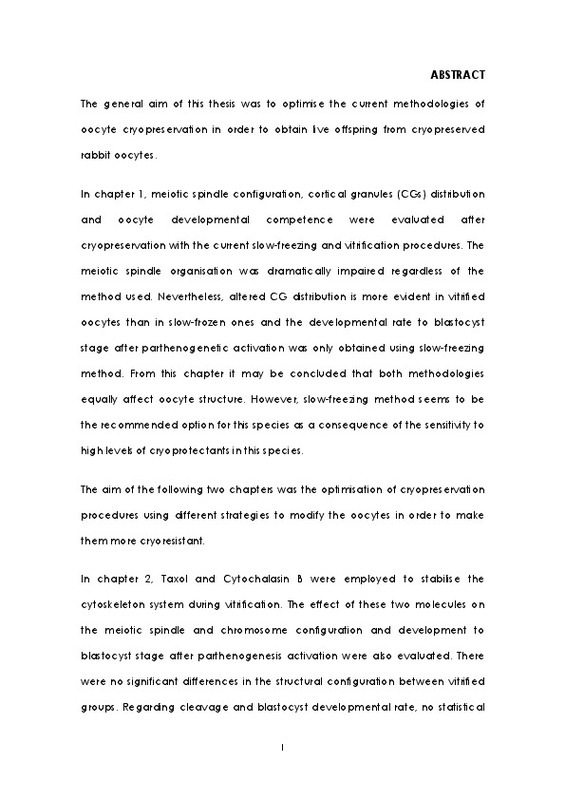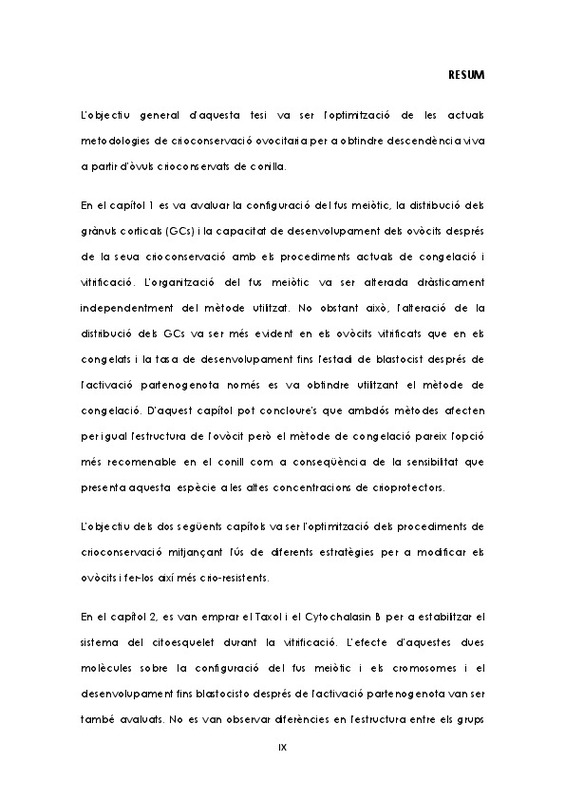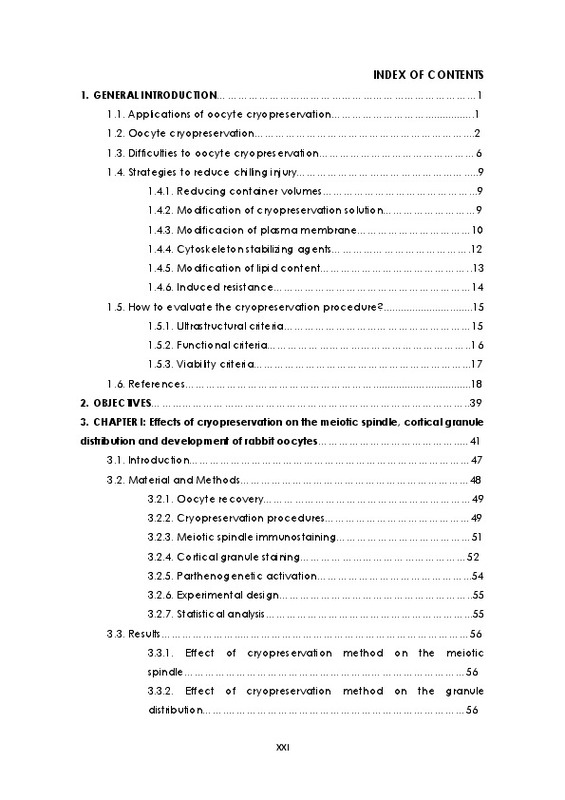- RiuNet repositorio UPV
- :
- Investigación
- :
- Tesis doctorales
- :
- Ver ítem
JavaScript is disabled for your browser. Some features of this site may not work without it.
Buscar en RiuNet
Listar
Mi cuenta
Estadísticas
Ayuda RiuNet
Admin. UPV
Generation of offspring from cryopreserved rabbit (Oryctolagus cuniculus) oocytes
Mostrar el registro sencillo del ítem
Ficheros en el ítem
| dc.contributor.advisor | Marco Jiménez, Francisco
|
es_ES |
| dc.contributor.advisor | Vicente Antón, José Salvador
|
es_ES |
| dc.contributor.author | Jiménez Trigos, María Estrella
|
es_ES |
| dc.date.accessioned | 2014-06-09T08:54:57Z | |
| dc.date.available | 2014-06-09T08:54:57Z | |
| dc.date.created | 2014-05-19T10:00:55Z | es_ES |
| dc.date.issued | 2014-06-09T08:54:52Z | es_ES |
| dc.identifier.uri | http://hdl.handle.net/10251/37977 | |
| dc.description.abstract | The general aim of this thesis was to optimise the current methodologies of oocyte cryopreservation in order to obtain live offspring from cryopreserved rabbit oocytes. In chapter 1, meiotic spindle configuration, cortical granules (CGs) distribution and oocyte developmental competence were evaluated after cryopreservation with the current slow-freezing and vitrification procedures. The meiotic spindle organisation was dramatically impaired regardless of the method used. Nevertheless, altered CG distribution is more evident in vitrified oocytes than in slow-frozen ones and the developmental rate to blastocyst stage after parthenogenetic activation was only obtained using slow-freezing method. From this chapter it may be concluded that both methodologies equally affect oocyte structure. However, slow-freezing method seems to be the recommended option for this species as a consequence of the sensitivity to high levels of cryoprotectants in this species. The aim of the following two chapters was the optimisation of cryopreservation procedures using different strategies to modify the oocytes in order to make them more cryoresistant. In chapter 2, Taxol and Cytochalasin B were employed to stabilise the cytoskeleton system during vitrification. The effect of these two molecules on the meiotic spindle and chromosome configuration and development to blastocyst stage after parthenogenesis activation were also evaluated. There were no significant differences in the structural configuration between vitrified groups. Regarding cleavage and blastocyst developmental rate, no statistical differences were found between vitrified-non-treated and Taxol-treated oocytes, but no oocytes treated with Cytochalasin B reached this stage. Therefore, structural configuration and blastocyst development were not improved by this pre-treatment. Moreover, Cytochalasin B pre-treatment seems to cause a deleterious effect on developmental ability to blastocyst stage of these oocytes. In chapter 3, oocytes were incubated with cholesterol-loaded methyl-ß- cyclodextrin (CLC) to increase the membrane fluidity and stability and improve their developmental ability after parthenogenetic activation or intracytoplasmic sperm injection (ICSI). Cholesterol incorporation and its presence after cryopreservation were evaluated using confocal microscopy. Results showed that cholesterol was incorporated into the oocyte and remained, albeit in a lesser amount after cryopreservation procedures. However, no improvements on developmental competence were obtained after parthenogenetic activation or intracytoplasmic sperm injection. In the last three chapters of this thesis, the main objective was to develop a reliable technique which would allow us to obtain live offspring from cryopreserved oocytes. For that purpose, in vivo fertilisation using intraoviductal oocyte transfer assisted by laparoscopy was considered a good alternative to bypass the inadequacy of conventional in vitro fertilisation in rabbit. In chapter 4, two recipient models (ovariectomised or oviduct ligated immediately after transfer) were used to compare the ability of fresh oocytes to fertilise in vivo. This first work showed that embryo recovery rates in all transferred groups decreased significantly, but ligated oviduct recipients provided significantly higher results compared to ovariectomised ones. For that reason, in the second experiment the ligated oviduct recipient model was used to generate live births. Results obtained in this chapter suggested that it was possible to obtain offspring from cryopreserved oocytes using this technique, but this kind of animal models compromised the use of the reproductive tract in a high percentage of females. For that reason, chapter 5 was focused on the development of another type of animal model as an alternative. First, the ability of cyanoacrylate tissue adhesive to block the oviducts before the ovulation would take place was evaluated. Then, in vivo fertilisation ability of fresh transferred oocytes after blocking the oviduct with the adhesive was also assessed. Finally, slow frozen oocytes were transferred to generate live birth. Results showed that cyanoacrylate tissue adhesive was effective in blocking the oviduct, as no embryos were recovered in the blocked oviduct six days after artificial insemination (AI). Moreover, this method could fertilise fresh and also slowfrozen oocytes with a higher live birth rate than the previous recipient models. This study showed that successful production of live offspring using slow-frozen oocytes in combination with in vivo fertilisation was possible, which suggested that in vivo environment could help improve the results of oocyte cryopreservation. Thus, this method was employed in the last chapter of this thesis to generate live offspring from vitrified rabbit oocytes for the first time. Results obtained revealed that there were no differences in the rate of birth between vitrified and slow-frozen transferred oocytes. Nevertheless, based on the results with fresh oocytes, further experiments are still needed if the efficiency of cryopreservation procedures are to be improved. | en_EN |
| dc.language | Inglés | es_ES |
| dc.publisher | Universitat Politècnica de València | es_ES |
| dc.rights | Reserva de todos los derechos | es_ES |
| dc.source | Riunet | es_ES |
| dc.subject | Cryopreservation | es_ES |
| dc.subject | Vitrification | es_ES |
| dc.subject | Slow-freezing | es_ES |
| dc.subject | Oocytes | es_ES |
| dc.subject | Rabbit | es_ES |
| dc.subject | Offspring | es_ES |
| dc.subject | In vivo fertilisation | es_ES |
| dc.subject | Laparoscopy | es_ES |
| dc.subject.classification | PRODUCCION ANIMAL | es_ES |
| dc.title | Generation of offspring from cryopreserved rabbit (Oryctolagus cuniculus) oocytes | |
| dc.type | Tesis doctoral | es_ES |
| dc.identifier.doi | 10.4995/Thesis/10251/37977 | es_ES |
| dc.rights.accessRights | Abierto | es_ES |
| dc.contributor.affiliation | Universitat Politècnica de València. Departamento de Ciencia Animal - Departament de Ciència Animal | es_ES |
| dc.description.bibliographicCitation | Jiménez Trigos, ME. (2014). Generation of offspring from cryopreserved rabbit (Oryctolagus cuniculus) oocytes [Tesis doctoral]. Universitat Politècnica de València. https://doi.org/10.4995/Thesis/10251/37977 | es_ES |
| dc.description.accrualMethod | TESIS | es_ES |
| dc.type.version | info:eu-repo/semantics/acceptedVersion | es_ES |
| dc.relation.tesis | 7244 | es_ES |
Este ítem aparece en la(s) siguiente(s) colección(ones)
-
Tesis doctorales [5389]






